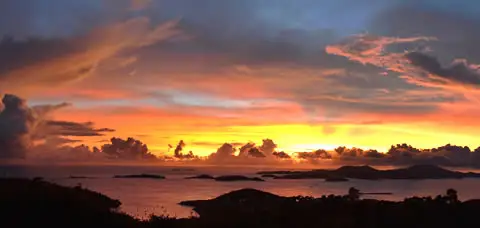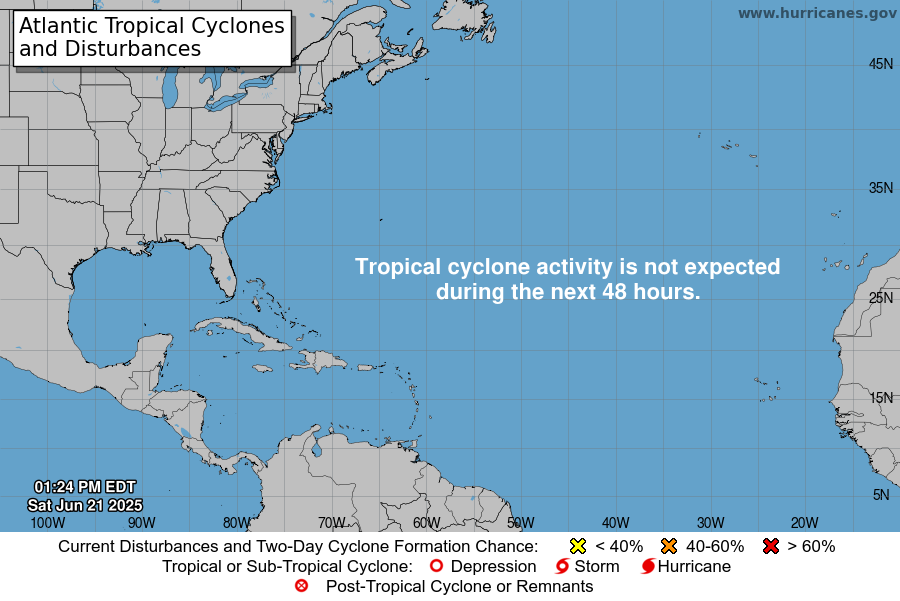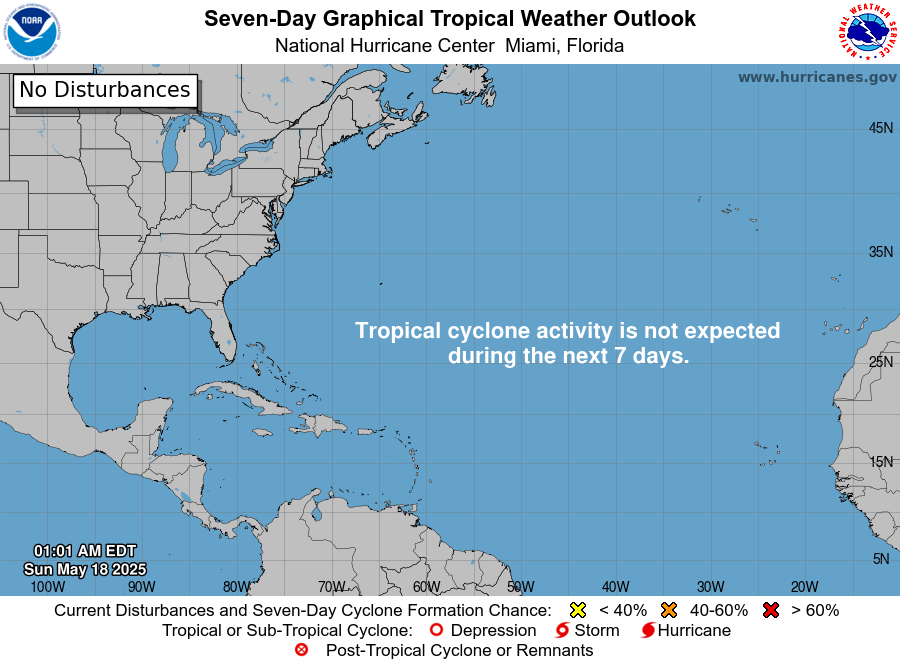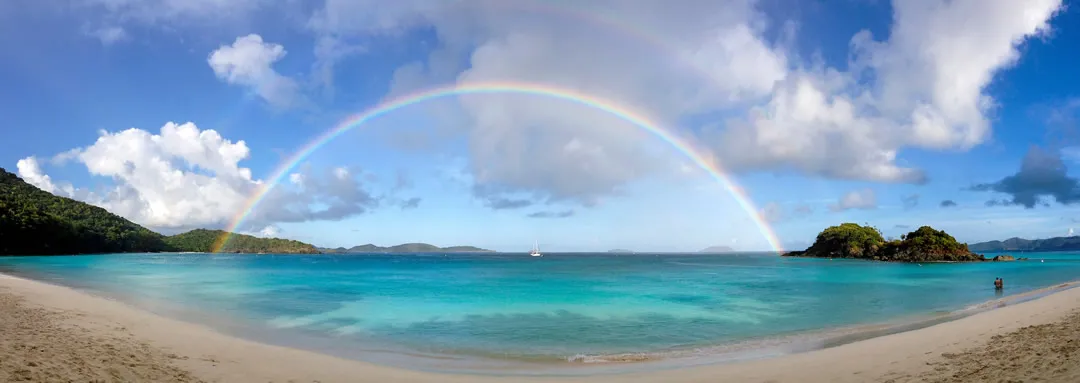
Whether you are visiting the Virgin Islands on vacation, or reside there, it helps to know what the weather has in store. This is especially relevant if you are heading out on the water,
Satellite Weather Loops
Zoom Level:
VI Weather Basics
For the most part, the weather here is nearly perfect. The defining characteristic of weather in the Virgin Islands is our trade winds. These are very dependable, blowing from a bit south of east in the summer months, and a bit north of east in the winter. The trade winds slacken a bit to 5 - 10 knots in late summer, and pick back up to 10 - 20+ knots in winter. In rare cases, winds can gust to well over 30 knots; be sure to check the current wind speeds (below) before you head out on the water.
As the moisture laden sea-surface trade winds encounter our hilly islands, they are forced upward, where they cool and release their moisture, creating a succession of westward-sculling cumulus clouds. These cotton-ball clouds contrast beautifully against our deep blue skies, and provide some welcome shade, but if you see one with a dark base due east of you, you may be in for a very brief tropical shower. In nearly all cases, the sun will pop back out within a few minutes.
Average daytime temperatures in the VI range from 84°F in winter to 89°F in summer, with average night-time temperatures ranging from 70°F to 76°F, respectively. Ocean temperatures at mid-day range from 81°F in February to 87°F in September.
The only exceptions to nearly perfect weather include about a week of unsettled weather as the trades swing from ESE to ENE, and back again. This usually occurs sometime in May, and again in November, and these are accordingly our rainiest months. During these transition periods, and briefly outside of them, low pressure systems above the VI can lead weather to stream off South America, and approach the VI from the south or south-east. The other exception to our nearly perfect weather is tropical storms, details of which are provided below.
Recent Weather
"What's Past is Prologue"
In 2011, we installed a weather station on the roof of the gazebo at Coconuts, on Gifft Hill, St. John, and with a hiatus after Irma, it's been producing weather data ever since. The graphs below provide a real-time record of the weather there for the previous and the current day. If you move your cursor over the weather graphs, hover pop-ups provide additional details. Note that Coconut's altitude is 750 feet, so the air temperature measurements there will typically be about three degrees cooler than those down at sea level.
Air Temperature & Dew Point (°F)
Wind Speed and Gusts (mph)
Wind Direction
Relative Humidity (%)
Rainfall and Daily Total (in)
Barometric Pressure (Inches of Mercury)
Five Day Forecast
Shower Icons? Don't Panic!
First-time visitors to St. John can become concerned when the forecast for their upcoming vacation shows several or mostly rainy days. No worries, mon! In almost all cases, this simply means that somewhere, sometime within the greater VI there will be a brief rain shower on that given day. In nearly all cases, the sun will pop back out after a few minutes. The official five-day weather forecast for St. John is as follows:
Coconuts

Gifft Hill, St. John
- Panoramic Ocean Views
- Spectacular Sunsets
- Heated Pool and Spa
- Three Bedrooms, Three Baths
- Fully Air Conditioned
- Under Ten Minutes to Cruz Bay
- Complete Privacy
- Indoor and outdoor kitchens
- Billiard porch with table tennis
- Home theater with film library and 100" screen
- Cornhole!
Plumeria

Gifft Hill, St. John
- Panoramic Ocean Views
- Spectacular Sunsets
- Heated Pool and Spa
- Three Bedrooms, Three Baths
- Fully Air Conditioned
- Under Ten Minutes to Cruz Bay
- Complete Privacy
- Indoor and outdoor kitchens
- Billiard porch with table tennis
- Home theater with film library and 100" screen
- Cornhole!
Tropical Storm Forecast
While the tropical storm season technically runs from June 1st to November 30th, the vast majority of storms cluster into August and September. For those concerned about tropical storms, please note that the Atlantic Ocean is vast, and both the eye of a storm and each of the Virgin Islands are quite small; the odds of a direct strike are therefore very low. St. John sustained substantial damage from Category 5 Hurricane Irma on September 6th, 2017. Prior to Irma, the last major hurricane to hit the VI was Category 3 Marilyn, twenty-two years earlier in 1995.
During storm season, tropical waves form off the western coast of Africa. Some will curve up into the central Atlantic; others may track closer to the VI. It takes about ten days for a tropical wave to make it to the VI, which gives us plenty of advance notice. Along the way it may be upgraded to a tropical depression, then a named tropical storm, and in a few cases each year, a hurricane. In nearly all cases, the storm center will pass safely north or south of the VI, but if the system is large, we can get heavy rains from its outer bands. Fortunately, these storms move quickly, so one or at most two days of inclement weather is all we get before the sun comes out again. But residents and visitors under ten days out should monitor any disturbances or named storms between the VI and the coast of Africa. Click on the "7 Day" button below to see the forecast cone of disturbances; for named storms, please check with the NHC, at the link in the text below the graphic.


During tropical storm season (June 1st to November 30th), detailed NHC discussions of any active hurricanes approaching the VI will be available below, in the scrollable “Tropical and Developing Storm Activity” section.
Tropical and Developing Storm Activity
Additional Hurricane Resources:
- In the event that a tropical storm or hurricane is approaching the VI, we recommend that you closely monitor additional information at the National Hurricane Center.
- Start by hovering over the red "X" or named storm icon in the graphic at the above NHC link, and reading the text in the pop-up window. Then click on "7-Day Tropical Weather Outlook" to see the forecast cone.
- Updates are made every six hours, at 0, 6, 12, and 18h UTC, which correspond to 8PM, 2 AM, 8 AM, and 2 PM EDT/AST. Individual updates will switch to every three hours once a disturbance becomes a named tropical storm.
- Additional technical details are also available once it is a named storm; these can be accessed by clicking on the storm symbol in the graphic at the above NHC link, and then clicking on "Discussion".
- For detailed "spaghetti models" with a number of track and intensity forecasts, check out Tropical Tidbits and Weathernerds.
- Early cycle track and intensity guidance can be monitored here about one hour after each NHC update: National Center for Atmospheric Research You will first need to click on the particular disturbance or storm in the global map.
- Informative and up to date commentary on active storms is also available at Eye On the Storm.
Windy!
Windy is an awesome tool to visualize tropical weather, and predict how potential storms will develop. In the graphic below, wind strength is color coded, and the remarkable Timebar at the bottom of the graphic allows you to see how the future will unfold. You can either click the lower left "Play" button to watch how supercomputers predict wind development over the next ten days, or simply drag the time to any specific point in the next ten days. Feel free to vary the zoom level via the + and - buttons at the upper right; you can also pan in any direction by simply clicking and dragging. Think of it as a magic time machine for tropical winds. Enjoy!
Sahara Dust Forecast
From April to October, high altitude winds can carry dust from the Sahara Desert into the Caribbean. When there is dust in the Virgin Islands, distant views will be hazy. The computer animation below provides a five day forecast for Sahara dust; levels above 20 will make distant views hazy. Fortunately, Sahara dust can clear out as quickly as it arrives. To see how quickly views can go from crisp to hazy (and back again), check out this post. Sahara dust also has its upsides; it plays an important role in suppressing hurricane activity. Over the millennia, dust transport from the Sahara built up the fertile Amazonian rainforest, and iron in the dust fertilized bacteria that built the limestone Great Bahama Bank.

Click start to animate:
Rough Seas & Surf Forecast
North Shore
For much of the year, the surf at St. John's North Shore beaches is very mild, even lake-like, and swell heights of concern to boaters are moderate (3 to 6 feet). In winter, storms far off at sea can send large swells our way, which will produce rough surf on exposed North Shore beaches such as Hawksnest, Trunk, and Cinnamon. In the summer months, passing tropical storms can briefly have the same effect. Be sure to check the North Shore swell graph before heading out on the water, or planning scuba dives on the North side of St. John.
Swell heights above 8 feet will produce rough surf, and at 10 - 12 feet or higher, Trunk Bay Beach is likely to be closed to swimming. Protected North Shore beaches include Caneel, Maho, and Francis, and any South Shore beaches are also great options when the North Shore seas are running high. The North Shore graph below plots the swell heights at a buoy 170 nautical miles north of St. John for the last 5 days. Spikes in swell height will take about 8 hours to arrive at St. John's north shore beaches, which provides useful advance notice of North Shore rough surf and seas. Note that the swells that reach the North Shore will be reduced in height compared to those at the buoy, due to buffering provided by Jost van Dyke, and the islands and cays to the north of Pillsbury sound.
South Shore
Much of the description from the North Shore discussion applies to seas and surf along St. John's South Shore, but the seasonality is different; rough seas and surf along St. John's South Shore are more likely in the summer months, when the trade winds shift to a bit south of due east. When the sea are high, you can even surf in some South Shore bays in the summertime! Unlike the North Shore buoy, the South Shore buoy is only 4 nautical miles south of St. John, so its swell height data is essentially real time. If you are planning to boat or dive on St. John's South Shore, it's worth checking this buoy data before heading out on the water.
Ocean Temperatures & Tides
The graphs below chart the ocean temperature at a buoy just south of St. John, as well as the tides at Lameshur Bay, on St. John's South Shore. Ocean temperatures in shallow waters swing about 2.5°F from early morning to mid-afternoon, when the ocean is at its warmest. Mid-afternoon ocean temperatures range from 81°F in February, to 87°F in September. The ocean stays pretty warm well into December, before ramping down to its "nippier" winter levels.
While St. John lacks any extended landmass to amplify tidal levels, significant tidal currents can occur, especially where adjacent islands such as Great Thatch channel tidal flows. Tidal currents may vary in timing and strength depending on where you are snorkeling. For exposed snorkels such as Waterlemon, please use caution, and return to shore if you encounter strong currents
Ocean Temperature (°F)
Tide Levels and Predictions (feet)
Marine Forecast
Before you head out on the water, be sure to check what the sea and sky has in store!
Virgin Islands
Caribbean/Atlantic
Visual Weather — The CocoPlum Cam
The "CocoPlum Cam" is located near the boundary between Coconuts and Plumeria, and provides an immediate visual check on the weather, along with a great live view out over Pillsbury Sound. Click on the "Play" icon to start live video. Moving your cursor over the video feed below will show controls to pause the video, or expand it to full screen. To return to the web page, simply hit the "Escape key", or click on the "Toggle full screen" icon. Our villas are located on the highest westward facing ridge on St. John, and provide spectacular sunset views. Be sure to check back around sunset time, or to catch your ferry in transit!
Trunk Bay Tourist Forecast
Fortunately, Trunk Bay is the only one of over 35 beaches on St. John that hosts cruise ship passengers. If this external link indicates that a number of cruise ships will be docking in St. Thomas on any given day, you should probably plan your visit to Trunk Bay for early morning, or late afternoon.
MegaYacht Forecast
St. John draws more than its share of remarkable mega-yachts, especially in high season. This external link allows you to check in on any large vessels within VI waters. Hovering over any vessel symbol will reveal its name, speed, and bearing. Clicking on its symbol will pull up an incredible amount of additional information on the vessel.
2024 Sunrise / Sunset / Moonrise / Moonset / Moon Phase Forecast
On many evenings and mornings in the Virgin Islands, nature puts on some pretty spectacular sunsets and sunrises. Sunsets are best viewed from the western, Cruz Bay side of St. John, while sunrises are best viewed from the eastern, Coral Bay side. We're a bit biased, of course, but are convinced that Gifft Hill, and especially our villas, offer the finest sunset panoramas on St. John. The sunset (or sunrise, for you east end early risers) show can last for nearly an hour, and some planning is required to ensure that you leave the beach (or Happy Hour bar) in time to find yourselves properly ensconced in the deck chairs or hot tub, libation in hand, shortly before the show begins. That brings us to the plots below, which tell you both when and where sunsets and sunrises will take place.
The "When" is shown in the upper plot, with the "Where" shown in the middle plot. The sunrise curves are yellow, while the sunset curves are red. Read the sunrise direction on the left-hand axis, and the sunset direction on the right-hand axis. 90 degrees is due East, and 270 degrees is due west. At the spring and autumn equinoxes (the first days of the spring and fall seasons), the sun rises precisely due east, and sets precisely due west. Day and night are equal on those days; "equinox" comes from the Latin words "aequi" (equal) and "nox" (night). The sun rises and sets the farthest south at the winter solstice, and rises and sets the farthest north at the summer solstice.
It's also nice to know when the moon will rise and set, as well as its phase. These times and phases are shown in the lower plot. The full moon rises just as the sun sets, and sets as the sun rises. On any given night, the moon will rise and set about 50 minutes later than it did the day before. If you're looking to do some stargazing in St. John's dark night skies, you'll want to choose a time a week or so either side of the new moon. When the moon is in the sky, its myriad craters are a gorgeous sight in even a small telescope. The moon's craters show best right along the shadow line, which advances from night to night. While the full moon is a fine thing to the eye, it is actually pretty washed out in a telescope; it's the shadow line that makes the craters pop, much as why you cast such a long shadow on the beach near sunset.
2024 Sunset & Sunset Times & Angles / Moonrise and Moonset Times & Phases
Hover over the graphs below to view the exact Sunrise/Sunset Moonrise/Moonset details for your chosen date:
Planetary Forecast
Planets (with the exception of Mercury) are fairly bright, and don't twinkle as stars do. Along with the Sun and the Moon,they always follow a path called "the ecliptic", which roughly runs from east to west across the sky. Here's a guide on where to find the naked-eye planets during the night sky in 2024:
2024 Calendar Year
- Mercury:
- This planet can be seen for several weeks to a month at a time, but only a few times each year. Look for it low in the west, shortly after sunset, and and never more than 15 to 20 degrees above the setting sun. Dates to catch Mercury in 2024 include a week or two either side of March 25th, late June thru late July, and (closer to the sun) late October thru late November. Binoculars can help to find it around those dates, but once you know where it is, Mercury can easily be seen by eye.
- Venus:
- Venus can only be seen in the pre-dawn sky for the first half of 2024. It enters the night sky just above the setting sun in late June, and remains low in the west after sunset for July thru September, slowly climbing in the western sky and getting brighter. For the remainder of the year, Venus gets higher and higher in the west after sunset, and will become increasingly bright. By the end of December, Venus will be setting over three hours after sunset.
- Earth:
- Look downward, mid-way between your two feet.
- Mars:
- Blood-red Mars is not well placed for viewing at night during most of 2024. It rises in the east around midnight in mid-August, and as the year continues, it rises earlier and earlier. At year's end, it will rise in the east about an hour after sunset.
- Jupiter:
- At the beginning of 2024, bright Jupiter is nearly overhead at sunset. Over the next few months, it shifts steadily westward, and sets in the west shortly after sunset by mid-May. Jupiter then leaves the evening sky, reappearing in the east around midnight in mid-August. By the end of 2024, it rises in the east around sunset, and will be visible higher in the east several hours later. Jupiter's four moons are easy to see in a small telescope, and change their position from night to night.
- Saturn:
- This planet with its beautiful system of rings can be seen in the southwest after sunset at the beginning of 2024, but by the end of February, Saturn will be lost in the sun's glare around sunset. Saturn returns to the night sky around mid-June, when it rises in the southeast around midnight. Over the next months, it will rise earlier and earlier, and by year's end, it will be high in the south at sunset. The visibility of Saturn's ring system varies over time in a seven-ish year cycle, and during 2024 and 2025, Saturn's rings will be nearly edge-on as seen from Earth. A few years after that, their visibility will be much better, and by 2030 to 2032, they will return to their full glory. Saturn's brightest moon Titan can be seen beside the planet in even a small telescope.
Rainbow Forecast
The Virgin Islands can serve up some pretty spectacular rainbows, but it's important to know when and where to look for them. The basic rule is that the center of the rainbow will always be 180 degrees away from the sun. This means that you will never see a natural rainbow at midday, because 180 degrees from the midday sun would be directly underground. The only time to see a full rainbow is either in the west, in the first hour or two after sunrise, or in the east, an hour or two before sunset. It also takes the right sort of passing cloud or brief tropical rain shower, but we have lots of those to improve the odds. The above charts for Sunrise and Sunset times and directions can also help. So, on the Cruz Bay side of things, look to the west for rainbows with your early morning coffee, and on the Coral Bay side, look east with your Happy Hour beverage. And be sure to look for a double rainbow, where a fainter copy of the glorious original appears about 10 degrees above it, and with a reversed order of colors.
You can also look for Moonbows. These are a lot fainter, with barely discernible colors, but can be really cool when you catch one. Look opposite a rising or setting full moon, with opposite rules to the above rainbow forecast: look west from Cruz Bay when the full moon rises in the east, an hour or two after sunset, and look east from Coral Bay as the full moon sets in the west, an hour or two before dawn.
Enjoy!

Early Morning Double Rainbow over Trunk Bay
St. John's Star-filled Nights
Surrounded by the VI National Park and the Caribbean Sea, St. John offers incredibly dark skies for stargazing. Nights are clearest in the winter months, when there is less water vapor, and no Sahara Dust to contend with, but incredible star-filled nights can occur in any season. In winter, Orion is directly overhead, while in summer, the Milky Way spans the night sky, with Sagittarius and Scorpius wheeling high in the South. The moon is a spectacular subject for binoculars and telescopes, but to observe the stars, it's best to look a week either side of a new moon. The phases of the moon are shown by icons as you hover over the Moonrise and Moonset plots a few sections up on this page. Below is an astrophoto that I assembled from a series of exposures on a clear January night. Click within the image to bring up a higher resolution version. Enjoy!